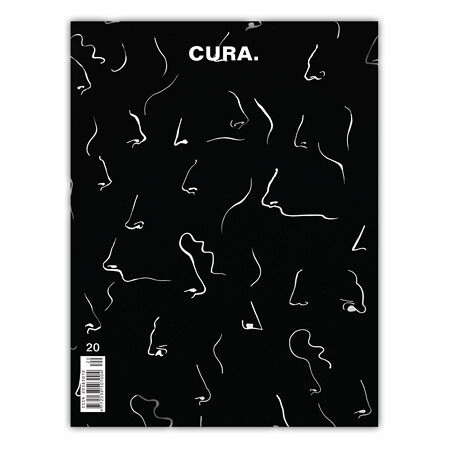www.curamagazine.com
Facebook / Twitter / Instagram
As usual, we’ve worked with a fantastic group of artists, designers and curators, sharing with them ideas, content, projects and new approaches to contemporary practices. As such, many changes occurred to CURA. in the last months, and we’re happy to welcome a series of new columns and contributors.
The new POP-UP section, focusing on a main topic, is cyclically investigated through the practice of leading international artists. The first series starts with Céline Condorelli in dialogue with Gavin Wade and James Langdon, leading us in the reasons of display, a central topic for many artists who have been working with and around it. The HOT! sectionhighlights a new generation of emerging artists and introduces a few “hot” names of the contemporary scenario: Olga Balema (by Chris Sharp), Darja Bajagić (by Franklin Melendez), Sasha Braunig (by Rose Bouthillier), and Rachel Rose (by Frances Loeffler).
In the frame that investigates new generations of artists, Hans Ulrich Obrist focuses on the young artist Marguerite Humeau, whose research “is not limited to biological hybridization and its histories,” but is also interested “in the ever-expanding forces of globalization and cultural homogenisation.”
Lisbon-based curatorial duo João Mourão and Luis Silva presents a new cycle of guided tours, where artists are invited to explain their work in the frame of the conceptual construction of a show and in function of the exhibition space. The first visit invites us to join the Museu Coleção Berardo in Lisbon, where Pedro Barateiro talks about his last exhibition, The Current Situation / Palmeiras Bravas.
So far so good! But there is still much to read and see.
If you have any questionyou ever wanted topose to Ryan Gander, just ask Adam Carr if he can do it for you! In the framework of a choral conversation, Adam collected questions from artists, curators and friends, and now Ryan replies by talking about inspiration, laziness, authorship, music, colors, artist’s expectations and much more.
Jenny Jaskey investigates Michael E. Smith‘s world through a paradox that allocates the artist’s work on the side of the “super-velocity of contemporary art.” The artist “takes on technological immersion, but flips the perspective: his work reflects on the decaying, crusty remains of the human, whose evolutionary time-scale is moving at such a slow pace that its corporeal shell is quickly becoming viewed as obsolete technology.”
“The power of the absurd is well understood by American artist Josh Kline,” writes Ciara Moloney in her essay—the first ever on the artist’s work to appear in a magazine—where the curator of his current exhibition at Modern Art Oxford investigates Kline’s purposes, who through the use of advanced technologies makes a profound investigation into the contemporary globalized political and economic conditions.
Also in the political framework of future perspectives can be read GCC‘s project. The collective, based in the Arabian Gulf, take their name from the English abbreviation for the Gulf Cooperation Council, a transnational political and economic union. GCC engages in a multidisciplinary practice that explores the construction of identities and systems across the purview of the contemporary Gulf society, including its bureaucratic, cultural and diplomatic arenas.
Two more artistic projects drive us into a surreal scenario. The talented Villa Design Group, supported by curator Nicoletta Lambertucci, leads the reader into a theatrical performance, drawn through costumes and dialogues. Meanwhile, artist Lena Henke andcurator Anna Gritz invite the audience to interact with the magazine by cutting pages and by recomposing them on the shape of New York City’s poster, “a pulsating sweating, screwing mass of buildings, that is both stage and protagonist of the artist’s work.”
From the future perspective of the mentioned artists, we go toward a dystopian vision into the past, with the curatorial section that opens the magazine as usual. Here, Lorenzo Benedetti introduces us to the figure of Wim Beeren and his main exhibition projects, where the visionary curator had introduced the contemporary artistic researches of his time into an institutional context. Meanwhile, Jean-Max Colard, after having talked about exhibition-characters in the past issue, focuses now on poetry in the exhibition space, examining how poetry has been used in the visual disciplines entering in exhibition spaces, thanks to artists like John Giorno and Karl Holmqvist.
What else?
The cover of this issue was designed by the British artist Allison Katz and is introduced by a text by Ruba Katrib.
Now we have done our work, you do yours.
Grab a copy of the magazine. Buy it! Read it! Mishandle it! Archive it!
You can find CURA. here, here, here, here, here and elsewhere!
Stay tuned!

